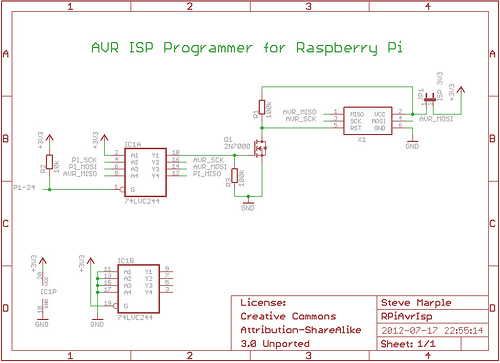
AVR/Arduino ISP programmer using the Raspberry Pi GPIOs

As a fully-featured Linux computer, many external programmers can be used with the Raspberry Pi to program the Atmel AVR range of microprocessors. It is also possible to utilize the general-purpose input/output lines (GPIOs) found on the Raspberry Pi to implement an in-system programming (ISP) programmer with minimal additional hardware. Although it can be accomplished without extra hardware, it is advisable to add a buffer and field-effect transistor (FET) for the protection of the Raspberry Pi. While it may seem unnecessary to include additional hardware when inexpensive external USB programmers are available, integrating an ISP programmer can be beneficial, especially if an extension PCB is being added to the Raspberry Pi for communication with a remote Atmel processor. Most of the Atmel AVR range can be programmed using an ISP interface that resembles the Serial Peripheral Interface (SPI) bus. For this description, it is assumed that the SPI pins are reused for this purpose, but it is important to verify this in the specific datasheet of the microcontroller. The RESET pin serves as the active-low chip select pin, SCK functions as the clock signal, MOSI is the input data pin, and MISO is the output data pin. The microcontroller operates as a SPI slave in this scenario, which clarifies the pin designations. The ISP programmer communicates with the microcontroller to send commands for reading or writing flash memory, EEPROM, fuses, and locks. Avrdude supports various programmers that can be utilized for this task. The simplest method on the Raspberry Pi involves using four GPIO pins to bit-bang the SPI commands; however, this is not recommended. After programming, the SPI interface on the microcontroller may revert to master mode, causing SCK and MOSI to become outputs. Connecting two logic outputs that may be at different logic levels can lead to issues. A safer interface should be implemented.
The design of an ISP programmer using the Raspberry Pi and Atmel AVR microcontrollers can be achieved with a straightforward circuit. The essential components include the Raspberry Pi, the Atmel AVR microcontroller, a buffer (such as a logic buffer or an operational amplifier configured as a buffer), and a FET for level shifting and protection.
The GPIO pins from the Raspberry Pi will be connected to the buffer inputs. The buffer outputs will then connect to the corresponding pins on the AVR microcontroller. This setup ensures that the GPIO pins from the Raspberry Pi are isolated from the microcontroller, preventing potential damage due to voltage mismatches or conflicting logic levels.
The RESET pin of the AVR should be pulled up to the supply voltage using a resistor, and it will be driven low by the Raspberry Pi GPIO to initiate programming. The SCK pin will be connected to a GPIO pin configured as an output, which will provide the clock signal for SPI communication. The MOSI pin will also be connected to a GPIO pin set as an output to send data to the microcontroller, while the MISO pin will be connected to a GPIO pin configured as an input to receive data from the microcontroller.
For programming, the Raspberry Pi will run software like Avrdude, which communicates through the GPIO pins to send commands to the AVR microcontroller. The commands can include reading and writing to flash memory and EEPROM, as well as programming fuses and lock bits. The design allows for a compact solution that leverages the Raspberry Pi's capabilities while providing a robust interface for programming Atmel AVR microcontrollers. Proper attention to the circuit layout and component selection will ensure reliable operation and protection for both the Raspberry Pi and the microcontroller.As a fully-featured Linux computer there are many external programmers that can be used with your Raspberry Pi to program the Atmel AVR range of microprocessors. It`s also possible to use the general purpose input/output lines (GPIOs) found on the Raspberry Pi to implement an ISP programmer with minimal extra hardware.
I say "with minimal extra ha rdware" because although it can be done with no extra hardware I recommend adding a buffer and FET to protect the Raspberry Pi. You might reasonably wonder what is the point if extra hardware should be used since external USB programmers can be bought cheaply from Ebay.
However, if you are going to add an extension PCB to your Raspberry Pi anyway, for instance to communicate with a remote Atmel processor, then including an ISP programmer makes sense and adds very little cost. Most of the Atmel AVR range can be programmed using an ISP interface which resembles the SPI bus. For this description I`ll assume that the SPI pins are reused for this purpose but you should check the datasheet to make sure this is true for your part.
The RESET pin is used as the active-low chip select pin, SCK is the clock signal, MOSI is the input data pin and MISO is the output data pin. If the directions seem odd remember that the microcontroller is acting as a SPI slave in this scenario; with that in mind the names make perfect sense.
The ISP programmer then communicates with the microcontroller, sending commands to read or write flash memory, EEPROM, fuses, and/or locks. Avrdude supports many different programmers which can be used for this task. The simplest interface on the Raspberry Pi is to use four GPIO pins and bit-bang the SPI commands. I don`t recommend this however. After programming has finished the SPI interface on the microcontroller could revert to master mode where SCK and MOSI become outputs.
Connecting two logic outputs together which could be at opposite logic levels is not wise. For a safer interface I used the circuit below. 🔗 External reference
The design of an ISP programmer using the Raspberry Pi and Atmel AVR microcontrollers can be achieved with a straightforward circuit. The essential components include the Raspberry Pi, the Atmel AVR microcontroller, a buffer (such as a logic buffer or an operational amplifier configured as a buffer), and a FET for level shifting and protection.
The GPIO pins from the Raspberry Pi will be connected to the buffer inputs. The buffer outputs will then connect to the corresponding pins on the AVR microcontroller. This setup ensures that the GPIO pins from the Raspberry Pi are isolated from the microcontroller, preventing potential damage due to voltage mismatches or conflicting logic levels.
The RESET pin of the AVR should be pulled up to the supply voltage using a resistor, and it will be driven low by the Raspberry Pi GPIO to initiate programming. The SCK pin will be connected to a GPIO pin configured as an output, which will provide the clock signal for SPI communication. The MOSI pin will also be connected to a GPIO pin set as an output to send data to the microcontroller, while the MISO pin will be connected to a GPIO pin configured as an input to receive data from the microcontroller.
For programming, the Raspberry Pi will run software like Avrdude, which communicates through the GPIO pins to send commands to the AVR microcontroller. The commands can include reading and writing to flash memory and EEPROM, as well as programming fuses and lock bits. The design allows for a compact solution that leverages the Raspberry Pi's capabilities while providing a robust interface for programming Atmel AVR microcontrollers. Proper attention to the circuit layout and component selection will ensure reliable operation and protection for both the Raspberry Pi and the microcontroller.As a fully-featured Linux computer there are many external programmers that can be used with your Raspberry Pi to program the Atmel AVR range of microprocessors. It`s also possible to use the general purpose input/output lines (GPIOs) found on the Raspberry Pi to implement an ISP programmer with minimal extra hardware.
I say "with minimal extra ha rdware" because although it can be done with no extra hardware I recommend adding a buffer and FET to protect the Raspberry Pi. You might reasonably wonder what is the point if extra hardware should be used since external USB programmers can be bought cheaply from Ebay.
However, if you are going to add an extension PCB to your Raspberry Pi anyway, for instance to communicate with a remote Atmel processor, then including an ISP programmer makes sense and adds very little cost. Most of the Atmel AVR range can be programmed using an ISP interface which resembles the SPI bus. For this description I`ll assume that the SPI pins are reused for this purpose but you should check the datasheet to make sure this is true for your part.
The RESET pin is used as the active-low chip select pin, SCK is the clock signal, MOSI is the input data pin and MISO is the output data pin. If the directions seem odd remember that the microcontroller is acting as a SPI slave in this scenario; with that in mind the names make perfect sense.
The ISP programmer then communicates with the microcontroller, sending commands to read or write flash memory, EEPROM, fuses, and/or locks. Avrdude supports many different programmers which can be used for this task. The simplest interface on the Raspberry Pi is to use four GPIO pins and bit-bang the SPI commands. I don`t recommend this however. After programming has finished the SPI interface on the microcontroller could revert to master mode where SCK and MOSI become outputs.
Connecting two logic outputs together which could be at opposite logic levels is not wise. For a safer interface I used the circuit below. 🔗 External reference





